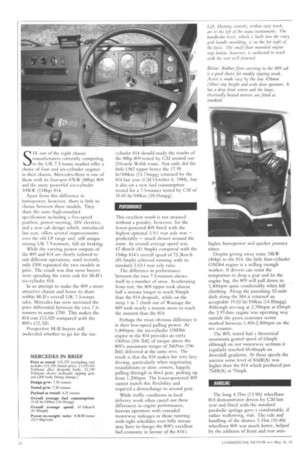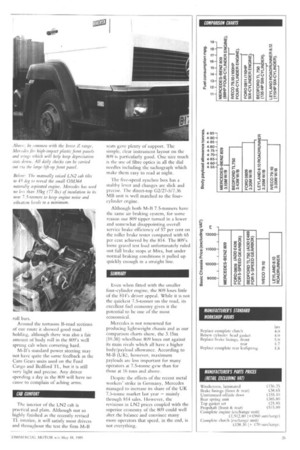S IX out of the eight chassis manufacturers currently competing in
Page 26

Page 27

If you've noticed an error in this article please click here to report it so we can fix it.
the UK 7.5 tonne market offer a choice of four and six-cylinder engines in their chassis. Mercedes-Benz is one of them with its four-pot 67kW (88hp) 809 and the more powerful six-cylinder 100kW (134hp) 814.
Apart from this difference in horsepower, however, there is little to choose between these models. They share the same high-standard specification including a five-speed gearbox, power steering, 24V electrics, and a new cab design which, introduced last year, offers several improvements over the old LP range and, still unique among UK 7.5-tonners, full air braking.
While the varying power outputs of the 809 and 814 are clearly tailored to suit different operations, until recently only £500 separated the two models in price. The result was that most buyers were spending the extra cash for M-B's six-cylinder 814.
in an attempt to make the 809 a more attractive chassis and boost its share within M-B's overall UK 7.5-tonne sales, Mercedes has now increased the price differential between the two 7.5tonners to some £700. This makes the 814 cost £.13,020 compared with the 809's £12,320.
Prospective M-B buyers still undecided whether to go for the six
cylinder 814 should study the results of the 88hp 809 tested by CM around our 210-mile Welsh route. Not only did the little LN2 tipper better the 17.95 lit/100km (15.73mpg) returned by the 814 last year (CM October 6, 1984), but it also set a new fuel consumption record for a 7.5-tonner tested by CM of 15.65 lit/100km (18.05mpg).
PERFORMANCE
This excellent result is not attained without a penalty, however, for the lower-powered 809 fitted with the highest optional 3.9: 1 rear axle was predictably much slower around the route. Its overall average speed was 67.4km/h (41.9mph) compared with the 134hp 814's overall speed of 73.3km/h (45.5triph) achieved running with its standard 3.63:1 rear axle ratio.
The difference in performance between the two 7.5-tonners shows itself in a number of areas. Accelerating from rest, the 809 tipper took almost half a minute longer to reach 50mph than the 814 dropside, while on the steep 1 in 7 climb out of Wantage the 809 took nearly a minute more to reach the summit than the 814.
Perhaps the most obvious difference is in their low-speed pulling power. At 1,400rprn, the six-cylinder 0M366 engine in the 814 provides an extra 136Nm (100 lbft) of torque above the 809's maximum torque of 266Nm (196 lbft) delivered at the same revs. The result is that the 814 makes for very lazy driving, particularly when negotiating roundabouts or slow corners, happily pulling through in third gear, picking up from 1,200rpm. The lower-powered 809 cannot match this flexibility and required a downchange to second gear.
While traffic conditions in local delivery work often cancel out these differences in engine performance, boxvan operators with extended motorway mileages or those running with tight schedules over hilly terrain may have to forego the 809's excellent fuel economy in favour of the 814's Left: Heating controls, within easy reach, are to the left of the main instruments. The handbrake lever, which is built into the entry grab handle moulding, is on the far right of the _facia. .1 Ire small floor mounted engine stop button, however, is awkward to reach with the seat well _forward.
Below: Rubber floor covering in the 809 cab is a good choice for muddy tipping work. Access is made easy by the low 456mm (18th) step height and wide door aperture. It has a deep front screen and the large, electrically heated mirrors are fitted as standard.
higher horsepower and quicker journey times.
Despite giving away some 34kW (46hp) to the 814, the little four-cylinder 0M364 engine is a willing enough worker. If drivers can resist the temptation to drop a gear and let the engine lug, the 809 will pull down to 1,400rpm quite comfortably when hill climbing. Along the punishing 52-mile dash along the M4 it returned an acceptable 19.02 lit/100km (14.85mpg). Although revving at 2,700rpm at 65mph the 3.97-litre engine was operating way outside the green economy sector marked between 1,400-2,400rpm on the rev counter.
The 809, tested had a theoretical maximum geared speed of 62iriph although on our motorway sections it regularly touched 65-66mph on downhill gradients. At those speeds the interior noise level of 83d8(A) was higher than the 814 which produced just 75dB(A) at 70mph.
HANDLING
The long 4.25m (13.9ft) wheelbase 814 demonstrator driven by CM last year and fitted with the standard parabolic springs gave a comfortable, if rather wallowing, ride. The ride and handling of the shorter 3.15m (10.4ft) wheelbase 809 was much better, helped by the addition of front and rear anti
Above: In common with the Iveco Z range, Mercedes fits high-impact plastic front panels and wings which will help keep depreciation costs down. All daily checks can be carried out via the large lift-up front panel.
Below: The manually raised LN2 cab tilts to 45 deg to reveal the small 0M364 naturally aspirated engine. Mercedes has used no less than 35kg (77 lbs) of insulation in its new 7.5-tonners to keep engine noise and vibration levels to a minimum.
roll bars.
Around the tortuous B-road sections of our route it showed good road holding, although there was also a fair amount of body roll in the 809's well sprung cab when cornering hard.
M-B's standard power steering may not have quite the same feedback as the Cam Gears units used on the Ford Cargo and Bedford TL, but it is still very light and precise. Any driver spending a day in the 809 will have no cause to complain of aching arms.
CAB COMFORT The interior of the LN2 cab is practical and plain. Although not so highly finished as the recently revised TL interior, it will satisfy most drivers and throughout the test the firm M-B seats gave plenty of support. The simple, clear instrument layout on the 809 is particularly good. One nice touch is the use of fibre optics in all the dial needles including the tachograph which make them easy to read at night.
The five-speed synchro box has a stubby lever and changes arc slick and precise. The direct-top G2/27-5/7.36 MB unit is well matched to the fourcylinder engine.
Although both M-B 7.5-tormers have the same air braking system, for some reason our 809 tipper turned in a lower . and somewhat disappointing overall service brake efficiency of 57 per cent on the roller brake tester compared with 65 per cent achieved by the 814. The 809's loose gravel test load unfortunately ruled out full brake stops at Mira, but under normal braking conditions it pulled up quickly enough in a straight line.
SUMMARY Even when fitted with the smaller four-cylinder engine, the 809 loses little of the 814's driver appeal. While it is not the quickest 7.5-tormer on the road, its excellent fuel economy gives it the potential to be one of the most economical.
Mercedes is not renowned for producing lightweight chassis and as our comparison charts show, the 3.1.5m (10.3ft) wheelbase 809 loses out against its main rivals which all have a higher body/payload allowance. According to M-B (UK), however, maximum payloads are less important for many operators at 7.5-tonne gvw than for those at 16 tons and above.
Despite the effects of the recent metal workers' strike in Germany, Mercedes managed to increase its share of the UK 7.5-tonne market last year — mainly through 814 sales. However, the revisions in LN2 prices coupled with the superior economy of the 809 could well alter, the balance and convince many more operators that speed, in the end, is not everything.




















































































